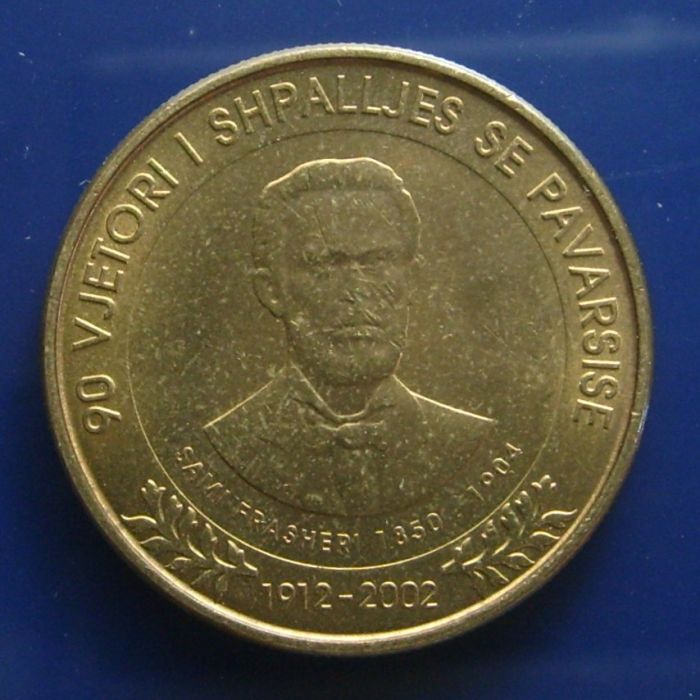Albania 50 Leke 2002 - Sami Frasheri - unc
€7.50
In stock
SKU
al0100
al0100 Albania 50 Leke 2002 km# 88 - Sami Frasheri - unc
| Catalog No. | km# 88 Schön# 86 N# 11795 |
|---|---|
| Send by Registered Mail | No |
| Value | 50 Leke |
| Year | 2002 |
Obverse: The value 50 Lekë in the centre and in the arch above there is the inscription "90th Anniversary of the Proclamation of Independence", in the arch below there is the inscription year 2002.
Reverse: The portrait of Sami Frashëri in the centre, below the portrait the date of birth and death, in the arch above there is the inscription "Shqipëri - Albania" and in the arch below year 2002.
These coins were minted by "Kremnica Mint", Slovakia.
The drawings of this coin were made by the painter Artan Peqini.
Proclamation of Independence
The struggle of the Albanian people for freedom and for the establishment of the Albanian state reached the climax during the period known as the National Renaissance, which started in the years 30-40 of the 19th century. This great democratic movement was crowned with the Proclamation of Independence.
The National Renaissance was set up and developed as both an armed war and an expanded cultural movement. The new liberation ideas were disseminated throughout the Balkan people; they found their first expression in N. Veqiharxhi, as well as in the Albanians (Arbëreshë) of Italy with the work of J. De Rada etc. They revealed the activity of the distinguished patriots and representatives of the Albanian culture, such as K. Kristoforidhi, P. Vasa, Th. Mitko, Z. Jubani, H. Tasini, J. Vreto etc., who were revolutionary followers of the Enlightment movement. The three brothers, the political leader Abdyl Frashëri, the ideologist and the patriot Sami Frashëri and the national poet Naim Frashëri, occupy a special place. The activity of the Renaissance people was based on the conviction that the Albanians are one of the most ancient people in the Balkan, with their own traditions, culture and language, with the right of making progresses in order to get the autonomy, and later on the full independence.
The National Renaissance was set up and developed as both an armed war and an expanded cultural movement. The new liberation ideas were disseminated throughout the Balkan people; they found their first expression in N. Veqiharxhi, as well as in the Albanians (Arbëreshë) of Italy with the work of J. De Rada etc. They revealed the activity of the distinguished patriots and representatives of the Albanian culture, such as K. Kristoforidhi, P. Vasa, Th. Mitko, Z. Jubani, H. Tasini, J. Vreto etc., who were revolutionary followers of the Enlightment movement. The three brothers, the political leader Abdyl Frashëri, the ideologist and the patriot Sami Frashëri and the national poet Naim Frashëri, occupy a special place. The activity of the Renaissance people was based on the conviction that the Albanians are one of the most ancient people in the Balkan, with their own traditions, culture and language, with the right of making progresses in order to get the autonomy, and later on the full independence.
The Albanian National Movement reached a new phase with the Albanian League of Prizren, founded in June, 10, 1878 which was the first political and military organization throughout Albania. The League enabled the recognition of the nation by setting up an Albanian administration, the official Albanian language and its own chief town. It also represented the Albanian nation in the international arena.
The Congress of Berlin (1878) decided the fragmentation of the Albanian territories. The Albanian League of Prizren organized the defence of Plava and Gucia, Hoti and Gruda, which were given to Montenegro by the Great Powers. The Albanian movement developed its activity further. A great number of patriotic associations were established (in Romania, Bulgaria, Egypt), the Albanian press developed, the Albanian School was opened in Korça in March, 7, 1887, important literary and political works were published, other writers started their creativity (A.Z. Çajupi, Asdren etc.).
The League of Peja (1899) responded to the new impetus of the uprisings and the requests for administrative autonomy, the unification into just one vilayet and the protection of the Albanian territories. The League performed its activity in the Kosovo vilayet and later on in that of Shkodra, Manastir and Janina. The High Porte broke it up forcefully (1900).
In 1905 the "Committee for the Liberation of Albania" was founded in Manastir, having branches in many towns in Albania. In 1908 the Congress of Manastir was convened to determine the Albanian alphabet, in September 1909 the Congress of Elbasan was convened and in December, 1, 1909 the first pedagogical school was opened in Elbasan.
The Turkish cast away their promises, implemented the Ottoman policy and pressed every manifestation of the movement for autonomy. The Albanians reacted with arms, armed uprisings burst out in 1909 in Kosovo, in 1911 in Shkodra Highland which was followed by the Memorandum of Greca for autonomy. They led to the general uprising in 1912. In July the uprising extended throughout the country.
The Albanian patriots, headed by Ismail Qemali acted outright to save the country from the fragmentation. After the defeat of the Turkish armies, Ismail Qemali, together with other patriots launched the idea of proclaiming the Albanian independence. On 28 November 1912 the National Assembly was assembled in Vlora to make the historic decision of the Proclamation of Independence. The national flag was raised and the first national government headed by Ismail Qemali was established.
Denomination: 50 Lekë
Alloy: CUAl5Zn5Sn1
Weight: 12 gr
Diameter: 28 mm
Colour: yellow
Mintage: 20000 pcs
If you want to see, the picture of the backside, just mail to: collectitcoins@outlook.com
And ask for backside; Albania 100

